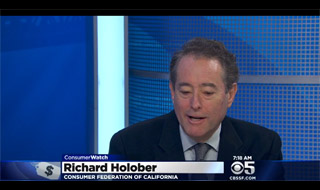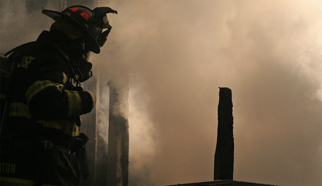Tag Archives: Toxic Flame Retardants
ConsumerWatch Weekend Roundup

Julie Watts’ featured guest on Saturday was Richard Holober of the Consumer Federation of California, whose organization is one of many consumer groups urging regulators to revise the standard for child car seat flammability. Read More ›
As An Insider Speaks Out, Chemical Industry’s Credibility Sinks
by the Editorial Board, The Sacramento Bee

Last year, Sen. Mark Leno, D-San Francisco, whose previous legislative attempts to restrict flame retardants had died in part because of [former industry lobbyist turned whistleblower Grant] Gillham, won approval of a bill requiring that products containing the flame retardants be labeled. Now, with Gillham as an ally, Leno is carrying a new bill, SB 763, which would require labeling of products for juveniles such as napping pads. It deserves passage, no matter what the American Chemistry Council says. Read More ›
American Chemistry Council Lied About Lobbying Role On Flame Retardants, Consultant Says
by David Heath, The Daily Beast

The American Chemistry Council has long maintained that it had nothing to do with an enormously successful but deceitful lobbying effort in state capitals to defend the use of potentially ineffective and toxic flame retardants in furniture. Now, in a rare breaking of ranks, a top industry consultant is discrediting that story. … He stepped up to a microphone at a California State Senate hearing to announce his support for a bill [CFC-co-sponsored SB 763] requiring labeling of children’s products containing the chemicals. Read More ›
Lawmaker Seeks To Squelch Flame Retardants
by Samantha Weigel, San Mateo Daily Journal

Leno said SB 763 is a continuation of his successful legislation last year that requires upholstered furniture such as beds and couches be labeled as to whether they contain flame retardant chemicals. Ultimately, the hope is informed consumers through market demand will phase out the use of flame retardants, Leno said. “Our new fire safety standard, equally fire safe … allows for compliance with or without the use of these toxic flame retardants,” Leno said. Read More ›
SB 763: CFC, Firefighters, Environmentalists Back Disclosure Of Chemical Hazards In Children’s Products

The Consumer Federation of California (CFC) has joined with professional firefighters and environmental advocates to co-sponsor legislation letting parents know whether products they buy for their children contain ineffective and hazardous flame retardants. … These chemicals have been linked to reproductive harm, cancer and other human health hazards. Fire safety experts consider them to be ineffective in preventing household fires. Read More ›
CFC, Firefighters, Environmentalists Back Disclosure of Chemical Hazards in Children’s Products
SACRAMENTO – The Consumer Federation of California (CFC) has joined with professional firefighters and environmental advocates to co-sponsor legislation letting parents know whether products they buy for their children contain ineffective and hazardous flame retardants. Read More ›
What You Need To Know About Toxic Chemicals Sprayed On Flame Retardant Furniture
by Anastasia Pantsios, Ecowatch

In late 2013, California passed new flammability standards which kicked in at the beginning of this month. While not banning flame retardants, they no longer require that furniture be resistant to open flame but only to smoldering cigarettes. Most upholstery fabrics meet that standard without chemicals, eliminating the need for fire-resistant foam underneath. For greater consumer protection, the state later added a requirement that products containing the chemicals be labeled. Read More ›
Concern Grows in Firefighters, Others After Cancer-causing Flame Retardants Found in Test Subjects
by Edward Ortiz, The Sacramento Bee

“Flame retardant may be the lead of the 21st century,” said Brian Rice, former deputy fire chief with the Sacramento Metro Fire District and president of Sacramento Area Firefighters Union Local 522. Rice started fighting fires in the 1980s. “I’m 55 and I feel like it is not a matter of if I will get cancer, but when.” … The new study should motivate consumers to ask for furniture without flame retardants when they buy new furniture and to wash their hands and keep dust levels at home low to reduce exposure. Read More ›
SB 1019: Governor Signs Toxic Furniture Right-to-know Bill

Californians can breathe easier since a new, non-toxic flammability test for upholstered furniture took effect January 1, 2014. However, the new regulation does not ban the use of dangerous halogenated chemicals as fire retardants, and the chemical industry is trying to persuade manufacturers to continue loading them into furniture sold in California. Senate Bill 1019 (Leno) would give consumers the right to know whether the furniture they buy is loaded with harmful chemicals. Read More ›
Public Safety, Worker Protection Bills Advance to Governor’s Desk

In a victory for public safety over private profitability, Senate Bill 1019 passed the state Assembly and Senate with strong bipartisan consent on August 27 and 28. Known as the Consumers’ Right to Know: Flame Retardants in Furniture bill, the measure – introduced by Senator Mark Leno, (D-San Francisco) — requires upholstered furniture manufacturers to disclose to consumers the use or absence of flame retardant chemicals on furniture labels. … The tide turned against the political power of the chemical industry’s continued use of toxic fire retardants in furniture over the past couple of years, said Richard Holober, executive director of the nonprofit Consumer Federation of California. Read More ›
Chemical industry fights for flame retardants
by Michael Hawthorne, Chicago Tribune

A leading manufacturer of flame retardants is suing California to block a new flammability standard that starting next year will allow furniture manufacturers to eliminate the chemicals from new upholstered sofas and chairs sold nationwide. Backers of the lawsuit also lobbied fiercely to thwart a California bill [SB 1019] that would require labels on any new furniture that still contains flame retardants. But much like earlier tactics embraced by the chemical industry, the latest legal and political maneuvers rely on flawed data and questionable claims about the effectiveness of flame retardants. Read More ›
Flame retardant bill wins important industry support
by Gary Cohn, Capital & Main

Furniture makers switched sides on SB 1019 after state Sen. Mark Leno agreed to clarify the definition of flame retardants. It’s still bitterly opposed by the chemical industry, whose campaign against regulation and public disclosure of flame-retardant chemicals is reminiscent of Big Tobacco’s fight against government controls. “The fact is that flame retardants have not been found to improve fire safety in our furniture and SB 1019 would provide consumers with truth-in-labeling for the first time,” said Judy Levin, pollution prevention co-director at the Oakland-based Center for Environmental Health. Read More ›
EWG-Duke study finds five times as much cancer-causing fire retardants in children as in mothers
by Environmental Working Group, press release

Environmental Working Group researchers teamed up with scientists at Duke University to test 22 mothers and 26 children. The results were disturbing: the urine in every mother and child tested yielded evidence of exposure to TDCIPP, a cancer-causing fire retardant. In the children, the average concentration of a chemical biomarker left when TDCIPP breaks down was nearly five times the average in the mothers. Read More ›